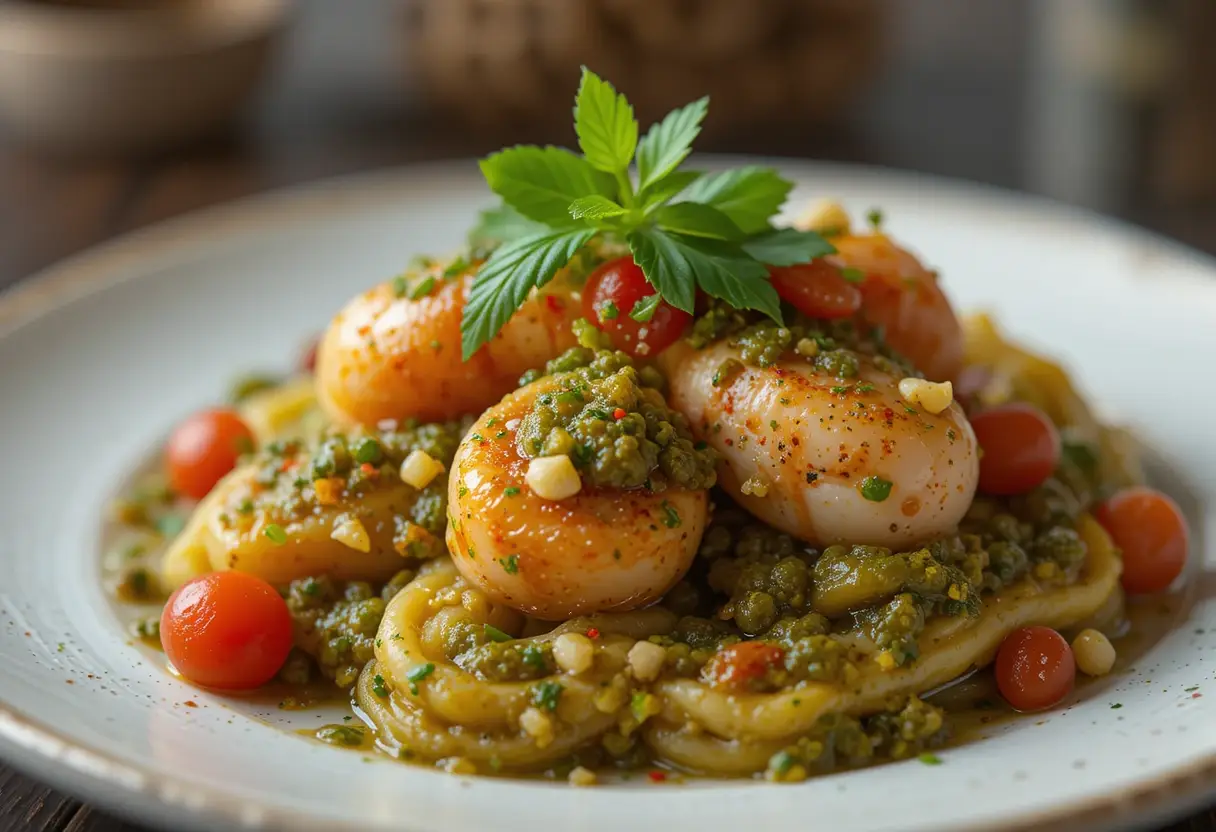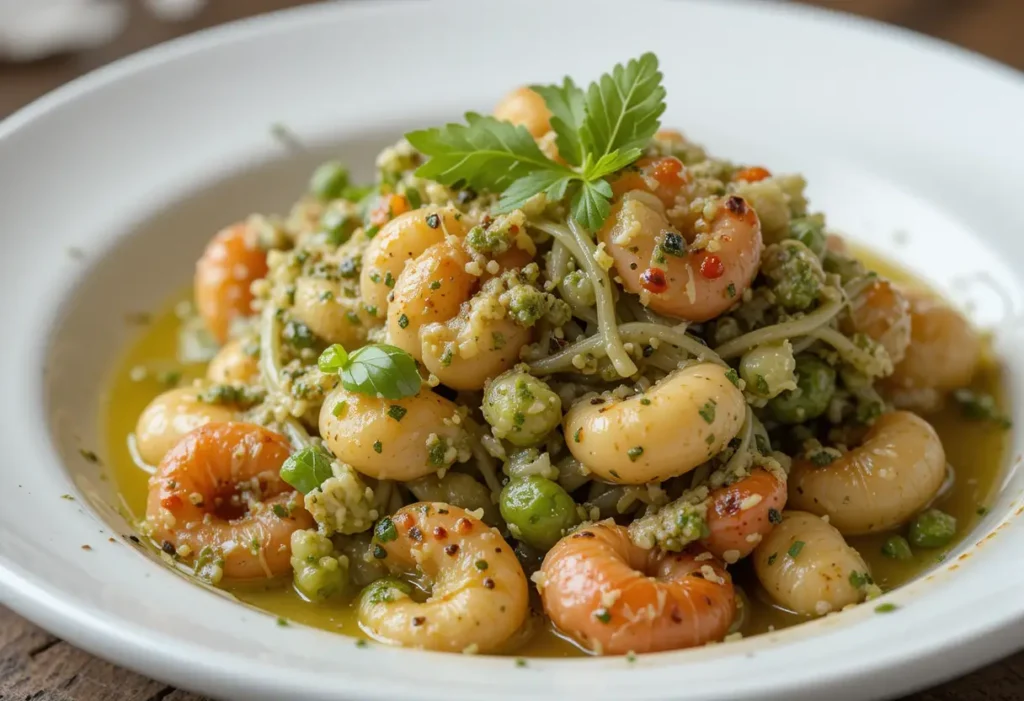Langostino, often called “little lobster,” is a type of shellfish known for its sweet, tender flavor and a texture that falls between lobster and shrimp. Despite its name, langostino is not a true lobster but is part of the crustacean family, like squat lobsters or crabs. Its unique taste and versatility make it the perfect ingredient for a variety of seafood dishes. One standout option is a Pesto Langostino Recipe, where the delicate sweetness of langostino is elevated by the rich, herbaceous flavors of pesto, creating a mouthwatering dish that’s both elegant and easy to prepare.
The Rich History of Pesto in Culinary Arts
Pesto traces its origins to Genoa, in the Liguria region of northern Italy. The word “pesto” comes from the Italian verb pestare, meaning “to pound” or “to crush,” a nod to the traditional preparation method of using a mortar and pestle. The classic recipe combines fresh basil, garlic, pine nuts, Parmesan cheese, and olive oil to create a vibrant, aromatic sauce. Over the years, pesto has evolved, inspiring variations that incorporate different herbs, nuts, and even vegetables. Its versatility makes it an ideal companion for langostino, offering a blend of fresh and savory flavors.
Essential Ingredients (by Quantity) for Pesto Langostino
Overview of Langostino
To prepare a delicious pesto langostino dish, start with the right quantity of high quality langostino:
- Langostino Tails: 1 pound (preferably pre cooked and peeled for convenience)
- Salt and Pepper: To taste, for seasoning the langostino
Types of Pesto for Langostino Dishes
The type of pesto you choose will significantly impact the flavor of your dish. Here’s a breakdown of common pesto varieties and their ingredient quantities for a single batch:
- Traditional Basil Pesto:
- Fresh Basil Leaves: 2 cups (packed)
- Garlic Cloves: 2 cloves
- Pine Nuts: 1/4 cup
- Grated Parmesan Cheese: 1/2 cup
- Extra Virgin Olive Oil: 1/2 cup
- Salt: 1/4 teaspoon
- Black Pepper: To taste
- Sun-Dried Tomato Pesto:
- Sun-Dried Tomatoes (packed in oil): 1 cup
- Garlic Cloves: 2 cloves
- Almonds or Pine Nuts: 1/4 cup
- Grated Parmesan Cheese: 1/2 cup
- Extra Virgin Olive Oil: 1/2 cup
- Salt and Pepper: To taste
- Spinach and Walnut Pesto:
- Baby Spinach Leaves: 2 cups (packed)
- Walnuts: 1/3 cup
- Garlic Cloves: 2 cloves
- Grated Parmesan Cheese: 1/2 cup
- Olive Oil: 1/2 cup
- Lemon Juice: 1 tablespoon
- Salt and Pepper: To taste
- Cilantro and Lime Pesto:
- Fresh Cilantro Leaves: 2 cups
- Lime Juice: 2 tablespoons
- Garlic Cloves: 1-2 cloves
- Toasted Cashews or Almonds: 1/4 cup
- Olive Oil: 1/2 cup
- Salt and Pepper: To taste
Additional Ingredients to Enhance Flavor
Incorporate these quantities of optional ingredients to complete your dish:
- Pasta (Optional): 12 ounces of linguine, spaghetti, or penne
- Vegetables (Optional):
- Cherry Tomatoes: 1 cup, halved
- Zucchini: 1 medium, diced or sliced
- Cheese:
- Grated Parmesan or Pecorino Romano: 1/4 cup for garnish
- Lemon Zest: 1 teaspoon
- White Wine (Optional): 1/4 cup for deglazing the pan during langostino preparation
- Butter (Optional): 2 tablespoons, for a creamy finish
These measured ingredients will ensure your pesto langostino dish is well balanced, flavorful, and visually appealing. Adjust quantities to suit your serving size and personal preferences.
Preparing Your Kitchen for Langostino Cooking
Necessary Kitchen Tools
To make cooking langostino dishes easier and more efficient, ensure you have the following tools:
- Cutting Board: For prepping vegetables and other ingredients.
- Sharp Knife: Essential for cleanly slicing vegetables and garnishes.
- Large Pot: Ideal for boiling pasta or blanching vegetables.
- Non-Stick Skillet or Grill Pan: For sautéing langostino or grilling.
- Blender or Food Processor: To create smooth and creamy pesto.
- Tongs or Spatula: For flipping and handling langostino.
- Mixing Bowls: To toss ingredients or prepare sauces.
- Zester or Microplane: For zesting lemon or grating cheese.
- Measuring Cups and Spoons: To ensure accurate ingredient proportions.
Pre-cooking Preparation Tips
- Thaw Langostino: If using frozen langostino tails, thaw them in the refrigerator overnight or under cold running water for quicker results.
- Pat Dry: Dry the langostino thoroughly with a paper towel to prevent excess moisture during cooking.
- Prepare Pesto: Make your desired pesto ahead of time and store it in an airtight container in the fridge for up to a week.
- Organize Ingredients: Measure and chop all ingredients before starting the cooking process.
- Preheat Cooking Surfaces: Heat your skillet, grill pan, or oven in advance to ensure even cooking.
- Boil Water for Pasta: If making a pasta dish, start boiling water with a generous pinch of salt.
Step-by-Step Cooking Guides
Classic Pesto Langostino Pasta
- Cook Pasta: Boil 12 ounces of pasta (spaghetti, linguine, or penne) until al dente. Drain and reserve 1 cup of pasta water.
- Sauté Langostino: Heat 2 tablespoons of olive oil in a skillet. Add 1 pound of thawed langostino tails, cooking for 2-3 minutes until warmed through.
- Combine with Pesto: Reduce heat, add 1/2 cup of prepared pesto, and toss with the pasta and langostino. Add reserved pasta water as needed for a silky sauce.
- Serve: Garnish with grated Parmesan cheese and a sprinkle of lemon zest.
Grilled Langostino with Pesto Butter
- Prepare Pesto Butter: Mix 1/2 cup of softened butter with 2 tablespoons of pesto in a bowl. Chill until firm.
- Grill Langostino: Preheat a grill pan or outdoor grill to medium heat. Lightly oil the surface and grill 1 pound of langostino tails for 2-3 minutes per side.
- Top with Pesto Butter: Remove from the grill and immediately top with dollops of pesto butter. Let the butter melt over the langostino.
- Serve: Accompany with grilled vegetables or a fresh salad.
Langostino Tacos with Pesto Drizzle
- Warm Tortillas: Heat 8-10 small corn or flour tortillas on a skillet until pliable.
- Cook Langostino: Sauté 1 pound of langostino tails with 1 tablespoon of olive oil and a pinch of salt and pepper for 2-3 minutes.
- Prepare Toppings: Dice 1 avocado, shred 1 cup of cabbage, and chop 1/2 cup of fresh cilantro.
- Assemble Tacos: Fill each tortilla with langostino, avocado, and cabbage. Drizzle with 2-3 tablespoons of prepared pesto.
- Serve: Garnish with lime wedges and optional hot sauce for added flavor.
These recipes bring out the best in langostino while highlighting the versatile and vibrant flavors of pesto. Enjoy experimenting with these delightful dishes!
Advanced Pesto Langostino Recipes
Fusion Dishes Inspired by Global Cuisines
- Pesto Langostino Risotto
- Combine the creamy richness of Italian risotto with the herbaceous zest of pesto and tender langostino tails. Cook Arborio rice with a splash of white wine, chicken or vegetable broth, and finish with a generous stir of pesto. Top with sautéed langostino and garnish with Parmesan.
- Thai Pesto Langostino Stir-Fry
- Blend traditional pesto with Thai-inspired flavors by adding coconut milk and a splash of lime juice. Stir-fry langostino with bell peppers, snap peas, and carrots, then toss with the Thai-style pesto for a refreshing twist.
- Langostino Tikka Pesto Skewers
- Marinate langostino tails in a mixture of yogurt, turmeric, and tikka masala spices. Grill on skewers and serve with a drizzle of cilantro lime pesto for an exciting Indo-Italian fusion.
Vegan and Vegetarian Alternatives
- Vegan Pesto with Langostino Substitutes
- Replace langostino with roasted king oyster mushrooms or jackfruit for a similar texture. Pair with vegan pesto made from basil, nutritional yeast, cashews, and olive oil for a dairy free, plant based dish.
- Vegetarian Pesto Langostino Pasta
- Opt for meat substitutes like hearts of palm or artichoke hearts for a vegetarian friendly alternative. Toss with classic pesto and pasta, and add sun dried tomatoes or roasted red peppers for extra depth.
- Pesto-Stuffed Portobello Mushrooms
- Scoop pesto and diced langostino substitutes into large Portobello mushroom caps. Top with bread crumbs and bake until golden and aromatic.
Nutritional Benefits of Pesto Langostino
Health Benefits of Langostino
Langostino is a nutrient rich seafood option that offers several health benefits:
- Low in Calories: Langostino is a lean protein source with minimal calories, making it ideal for weight management.
- Rich in Protein: It provides high quality protein essential for muscle repair and growth.
- Omega-3 Fatty Acids: These beneficial fats support heart health, reduce inflammation, and promote brain function.
- Vitamin and Mineral Content: Langostino contains selenium, vitamin B12, and magnesium, which are important for immune health, energy production, and bone strength.
Caloric and Nutritional Information
Here’s an approximate breakdown of the nutritional profile for 3 ounces (85g) of langostino:
- Calories: 70-80
- Protein: 15-17g
- Fat: 1g (primarily omega-3 fatty acids)
- Carbohydrates: 0g
- Sodium: 200-250mg
Nutritional Value of Pesto (per 2 tablespoons):
- Calories: 160-180
- Protein: 3g
- Fat: 16g (from olive oil and nuts)
- Carbohydrates: 2g
When combined, pesto and langostino provide a balanced meal rich in healthy fats, lean protein, and flavorful herbs. Adjust portion sizes to meet your dietary goals while enjoying this delicious dish.
Storing and Reusing Pesto Langostino Leftovers
Safe Storage Practices
- Proper Cooling: Let cooked langostino and pesto dishes cool to room temperature within two hours to avoid bacterial growth.
- Airtight Containers: Store leftovers in sealed, airtight containers to maintain freshness and prevent contamination.
- Refrigeration: Keep in the refrigerator at 40°F (4°C) or lower, and consume within 2-3 days for optimal quality.
- Freezing: For longer storage, freeze pesto separately in ice cube trays for portioned use, and freeze langostino in freezer safe bags or containers. Use within 2-3 months.
- Reheating Safely: When reheating, warm gently over low heat to preserve texture and flavor, especially for langostino.
Troubleshooting Common Cooking Issues
Solutions for Overcooked Langostino
- Hydration: Mix over cooked langostino with a light sauce, melted butter, or olive oil to add moisture and mask dryness.
- Cold Applications: Use in cold dishes like salads or wraps, where the texture won’t be as noticeable.
- Mince and Blend: Chop finely and incorporate into mixed dishes such as seafood dips, tacos, or stuffed vegetables.
- Avoid Further Heat: Do not reheat overcooked langostino. Instead, serve it cold or at room temperature in dishes where texture is secondary to flavor.
Adjusting Pesto Flavors
- Too Strong (Garlic or Herbs): Add more olive oil, Parmesan cheese, or a handful of spinach to dilute intense flavors.
- Too Salty: Counterbalance with lemon juice, a pinch of sugar, or extra unsalted nuts or cheese.
- Too Bitter: Blend in a small amount of cream, honey, or ricotta cheese to mellow the bitterness.
- Too Oily: Stir in water, vegetable broth, or lemon juice to lighten the texture and tone down the oiliness.
- Lacking Flavor: Brighten the taste with extra garlic, a pinch of salt, freshly grated Parmesan, or a squeeze of lemon juice.
By following these tips, you can safely store and creatively reuse your pesto langostino leftovers, as well as troubleshoot common cooking mishaps to perfect your dish!
FAQ: Everything You Need to Know About Pesto Langostino
Can I use frozen langostino?
Yes, frozen langostino is a convenient and excellent choice for making pesto langostino dishes. Here are some tips for using frozen langostino effectively:
- Thaw Properly: Thaw frozen langostino in the refrigerator overnight or under cold running water to prevent textural changes.
- Drain Excess Water: Pat the langostino dry with paper towels before cooking to avoid excess moisture.
- Use Quickly: Once thawed, use langostino promptly to maintain its freshness and flavor.
Frozen langostino is typically pre cooked, so it requires minimal cooking time to avoid overcooking.
What are the best pestos to use?
The best pesto for langostino depends on your flavor preferences, but here are some popular options:
- Classic Basil Pesto: The traditional blend of basil, garlic, pine nuts, Parmesan, and olive oil is a perfect match for langostino.
- Sun-Dried Tomato Pesto: Adds a sweet and tangy depth that complements the mild flavor of langostino.
- Cilantro and Lime Pesto: Offers a zesty and refreshing twist, ideal for lighter or more tropical dishes.
- Spinach and Walnut Pesto: Provides a nuttier and earthier flavor for those seeking a less traditional approach.
- Arugula and Almond Pesto: For a peppery and slightly nutty variation, perfect for adventurous cooks.
Feel free to experiment with your own pesto recipes, adding ingredients like lemon zest, roasted garlic, or different nuts for a personalized touch.
Tips for First-Time Cooks
- Start Simple: Begin with a classic pesto langostino pasta recipe. It’s easy to prepare and highlights the natural flavors of both langostino and pesto.
- Don’t Overcook: Langostino is pre cooked in most cases and only needs to be warmed through. Overcooking can make it rubbery.
- Taste and Adjust: When making pesto, taste as you go. Adjust salt, garlic, or lemon juice to balance the flavors.
- Prep Ingredients First: Have all ingredients measured and prepared before starting. This ensures a smooth cooking process.
- Experiment with Pairings: Try adding vegetables, pasta, or grains to your langostino and pesto for a complete meal.
- Use Fresh Ingredients: Whenever possible, use fresh herbs, high quality olive oil, and freshly grated cheese for the best flavor in your pesto.
By following these tips and experimenting with flavors, even first time cooks can create delicious pesto langostino dishes with ease and confidence.
Conclusion: Discover the Magic of Pesto Langostino
Pesto langostino is a flavorful seafood delight that brings a perfect blend of tender langostino and vibrant pesto. Whether you’re preparing a classic pasta dish or exploring creative recipes like tacos or fusion risottos, pesto langostino is a versatile choice for any meal. Maximize your cooking potential with easy storage tips, flavorful pesto variations, and troubleshooting solutions for common cooking challenges. For more seafood inspiration, try this delicious Mediterranean Salmon Recipe or explore the rich flavors of Pineapple Chili Salmon. Dive into the world of pesto langostino today and enjoy every bite!


